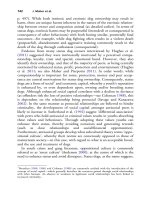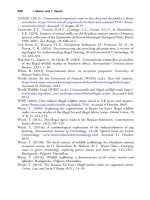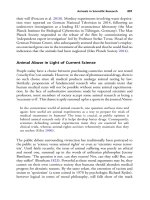The palgrave international handbook of a 120
Bạn đang xem bản rút gọn của tài liệu. Xem và tải ngay bản đầy đủ của tài liệu tại đây (27.31 KB, 1 trang )
110
A. Arluke et al.
per year calculated above is of the right order of magnitude, although it is
possible that the actual number of cases is significantly higher.
Animal hoarding is not limited to any one culture or country. Reports have
been published regarding cases in Alberta, Canada (Avery 2005); Manitoba,
Canada (Refinish 2009); New South Wales, Australia (Joffe et al. 2014);
Victoria, Australia (Ockenden et al. 2014); Belgrade, Serbia (Marijana and
Dimitrijevic 2007) and Spain (Calvo et al. 2014).1
Severity
Animal cruelty in general has increasingly been viewed as a serious problem
as evidenced by stronger anti-cruelty laws, increasing prosecutions and
growing concern about the connection between some animal cruelty offenses
and the potential for other forms of criminal activity and interpersonal
violence (Phillips and Lockwood 2013). Animal hoarding is increasingly
viewed as a serious problem by law enforcement and animal protection
professionals. The first concern is the large number of animals involved.
Cases involving hundreds of companion animals are common.
Another concern is the duration of suffering to which animals in hoarding
situations may be exposed. Many live a life where their basic needs for food,
water, shelter, a sanitary environment, safety, social interaction and veterinary care are rarely or inconsistently met, causing extended suffering before
they eventually die a slow and lingering death from starvation or disease.
Hoarding can also have long-term behavioral effects on animals even after
they are removed from the situation and placed in loving homes. McMillan
(2013) surveyed 388 adopters of dogs from hoarding cases using the Canine
Behavioral Assessment and Research Questionnaire (CBARQ) that had been
used in earlier studies of rescued puppy mill dogs. (McMillan et al. 2011). At
the time of removal from the hoarding environment, 88 % of the dogs were
characterized as having behavioral, emotional or psychological problems.
Upon follow-up several months later, 44 % were still reported to have
moderate to severe behavior problems.
Yet another concern about animal hoarding cases is the enormous cost
associated with responding. Housing, treating and caring for animals rescued
from hoarding situations can be extremely expensive, particularly if they
must be held as ‘evidence’ for a prolonged period (Bernstein and Wolf 2005).
1
Although there are many press reports from the UK, the authors are unaware of any similar UK case
summaries in the literature.









